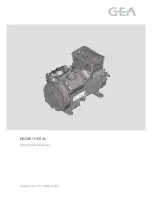
Operating manual - SAB 120-151 A-frame (including ATEX)
008668 en 2019.08
41/61
6.16
Compressor oil cooling system
The unit can be equipped with one of several systems for controlling the compressor oil tempera-
ture. They are single or dual-port liquid injection, thermosyphon, or water-cooled oil coolers.
Each system is automatically controlled, independent of compressor loading or unloading.
Oil cooling systems maintain oil temperature within the following ranges for R717 and R22:
Liquid injection oil cooling:
55-65°C
External* oil cooling:
49-60°C
* Refrigerant-cooled (Thermosyphon) oil cooling (TSOC) or water-cooled oil cooling (WCOC).
6.17
Single-port liquid injection
The single-port liquid injection system is designed to permit liquid refrigerant injection into one
port on the compressor at any given moment and operates as outlined.
The liquid injection solenoid valve is energised by the microprocessor when the temperature sen-
sor, installed in the compressor discharge, exceeds the set point. High-pressure liquid refrigerant
is then supplied to the temperature control valve ( TCV).
Refer to
P&I diagrams
section for piping and instrumentation drawings.
6.18
Dual-port liquid injection
The dual-port liquid injection system is designed to obtain the most efficient compressor perform-
ance at high and low compression ratios by permitting injection of liquid refrigerant into one of
two ports optimally located on the compressor. This minimises the performance penalty incurred
with liquid injection oil cooling.
The dual-port system contains all the components of the single-port system with the addition of a
double-acting solenoid valve and operates as outlined.
The liquid injection solenoid valve is energised by the microprocessor when the temperature sen-
sor, installed in the oil manifold, exceeds the set point. Liquid refrigerant is then passed through
the temperature control valve (TCV) to the double-acting solenoid valve. Depending on the com-
pressor’s operating volume ratio (Vi), the microprocessor will select the flow of the liquid refriger-
ant to the optimum compressor port.
6.19
Suction check valve bypass
A 1/4" angle valve is installed between the compressor and suction flange. It can be used as a
suction valve bypass. This feature has several uses including reducing starting torque, improving
oil quality, and relieving the refrigerant to low side for servicing.
In most cases, the valve should be left open approximately 1 to 2 turns at all times. If the com-
pressor back-spins or too much oil foaming is experienced while venting, partially close valve to
slow speed of equalisation. If system is on AUTO CYCLE and short cycling occurs, the valve must
be closed.
To relieve refrigerant to low side, close the separator discharge service valve. Slowly open the by-
pass valve (if closed), and wait for pressure to equalise. Close bypass and suction service valves
before evacuating the unit.
















































